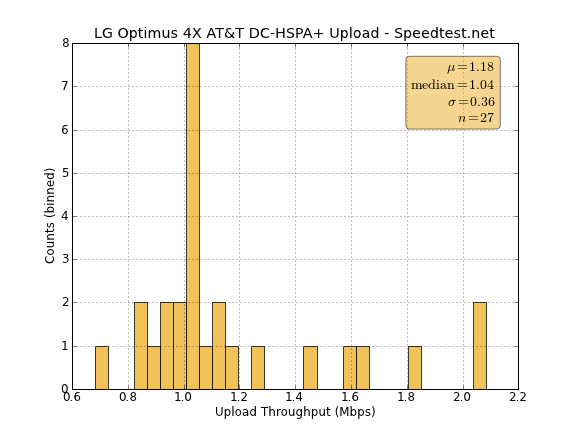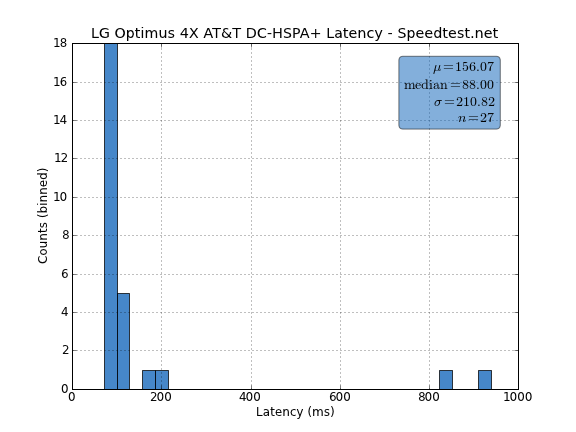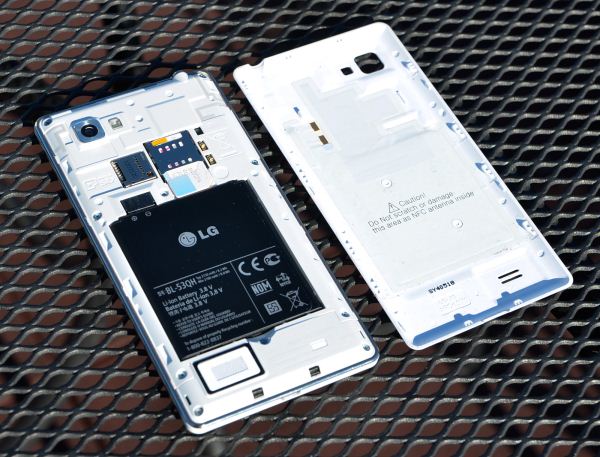LG Optimus 4X HD: Tegra 3 Handsets Stay Global
by Vivek Gowri on August 29, 2012 4:30 AM EST- Posted in
- Smartphones
- LG
- Ice Cream Sandwich
- Mobile
- Tegra 3
The cellular heart of the O4X is Intel’s XMM6260 mobile baseband, a 40nm part that is essentially a platform containing X-Gold’s 626 modem and the Infineon SMARTi UE2 RF transceiver DSP, along with the 3GPP Release 7 HSPA+ protocol stack with support for HSPA Category 14 (21.1 Mbps, which qualifies as HSPA+) downlink and Category 6 (5.76 Mbps) uplink speeds. The speeds are pretty standard these days, and nothing to raise any eyebrows in the days of mobile broadband that’s faster than a lot of home internet connections. At this point in time, LTE networks aren’t nearly as common in Asia as they are in American metropolitans, so the pressure to ship LTE devices in the international market is relatively low. This is why you see the international versions of the new high end devices shipping with HSPA+ instead of the 4G-branded LTE/DC-HSPA+ that tend to rule in the US market.
We’re pretty familiar with this modem already, actually. Among other devices running XMM6260 and/or X-Gold 626? The GSM/HSPA+ Galaxy Nexus, the LG Thrill/Optimus 3D, the Lava Xolo X900, and the international versions of the One X, the Galaxy S II (GT-I9100), and the Galaxy Note (GT-N7000). And that’s not even scratching the surface, there are a plethora of devices running some variant of this baseband, including ones from Huawei and Lenovo. XMM6260 isn’t the latest and greatest anymore, but it’s a very solid, reliable baseband processor that seems to be the go-to component choice for a single-carrier HSPA+ modem.
The O4X supports the requisite quad-band GSM and WCDMA, which, as a T-Mobile user, left me out in the cold, dark world of EDGE data speeds. (Side note: this is the other reason I love the G-Nex. Pentaband WCDMA is like Red Bull, it gives you wings - a truly liberating feeling. I wish more phones had it.) I made good use of Airtel’s HSPA+ network in India, and got data speeds ranging anywhere from 50 kbps to 4 Mbps depending on where I was. It was variable, to say the least, but as long as I stayed in metropolitan areas, I found the mobile broadband pretty livable.



In the US, I did my network testing on AT&T because, really, who wants to use a phone with only an EDGE data connection? (All you T-Mobile iPhone users, I seriously question the amount of pain you go through just to have an iPhone on the Big Magenta. I wouldn’t consider it until T-Mobile converts a significant portion of their PCS band to WCDMA, which can’t happen quickly enough.) I saw download speeds mostly in the 4-7 Mbps range, occasionally dropping down into the 2 Mbps range when signal strength was low, with upload speeds usually somewhere in the 1-1.5 Mbps range. Pretty standard stuff, all the way around.











46 Comments
View All Comments
lowlymarine - Wednesday, August 29, 2012 - link
The chart on the first page says the Galaxy Nexus has an "ARM Mali-400" for the GPU, but I'm fairly certain it actually uses a PowerVR SGX540.lowlymarine - Wednesday, August 29, 2012 - link
Also, no version of the Galaxy Nexus has a MicroSD slot, to my knowledge. And on page 7:"from an optical standpoint it comes with what I believe is a 4P (4 plastic elements) system with a focal length of <focal>mm."
Not sure what's going on there.
Excellent review overall though. I have to agree on the button layout, it's a shame they didn't use the ICS default buttons ans instead chose to stick to a legacy menu button.
VivekGowri - Wednesday, August 29, 2012 - link
Missed a couple of things when I was switching it from SGS2 to the Galaxy Nexus. The focal length is 3.2mm - I just put in a placeholder when I was writing and simply forgot to put in the value when the review went live.Skidmarks - Wednesday, August 29, 2012 - link
It seems to have very capable hardware but is truly a dreadful looking thing IMO.Belard - Wednesday, August 29, 2012 - link
Agreed... then again, look at it this way. When a touch-screen device, such as a phone is made - everything is made around the screen. Right? That doesn't leave much room for much of anything else. Other than the size, thickness, materials, placement of buttons. If you GO BACK in time in the days of candy-bar, sliders, flip-phones - someone like SONY alone had about 60 different phones on the market at once time. Now SONY has about a dozen active smart phone designs (almost all are rectangle with curved corners) - some are quite attractive. But few are available - or they are at the SONY STORE at full price. at&t only sells 1 SONY phone. (I don't consider SONY because their track record with Android is sub-par at this time and their love for those rubber covers over the USB port which I have to fight to remove)You had different colors, different shape of buttons, different size screens. Remember the days of the LG Chocolate?
The required touch-screen kill design ideas. But looking at MC/ Samsung / SONY and NOKIA - there are style DNA that can still be applied to the shape. SONY's style tends to make the phone bulkier than it should be.
Mike0 - Wednesday, August 29, 2012 - link
Also, the International One X has 32GB NAND, not 16GB unless you're referring to the Snapdragon S4 variety which would be useless in this comparison :PMike0 - Wednesday, August 29, 2012 - link
And it's screen is Super LCD2, if you're including technical terms like SAMOLED.Mike0 - Wednesday, August 29, 2012 - link
Also also, (last one I promise :P) the latest 4.0.4 update for the One X International dramatically improves it's scores in BrowserMark (Some people are getting 125000+) and Vellamo (Over 2000 now) and probably more benchmarks so it may be worth updating your results.VivekGowri - Wednesday, August 29, 2012 - link
Yeah, I copied the table over from another review and missed a few things when I was changing them. Missed the GPU/SD card thing when I changed from SGS2 to SGN, and the NAND when I changed from One X (AT&T) to One X (Intl.) Should be fixed now though.arnoudw - Thursday, August 30, 2012 - link
The update to 4.0.4 also drastically improved battery life. Here are some tests: http://tweakers.net/nieuws/83464/update-htc-one-x-...